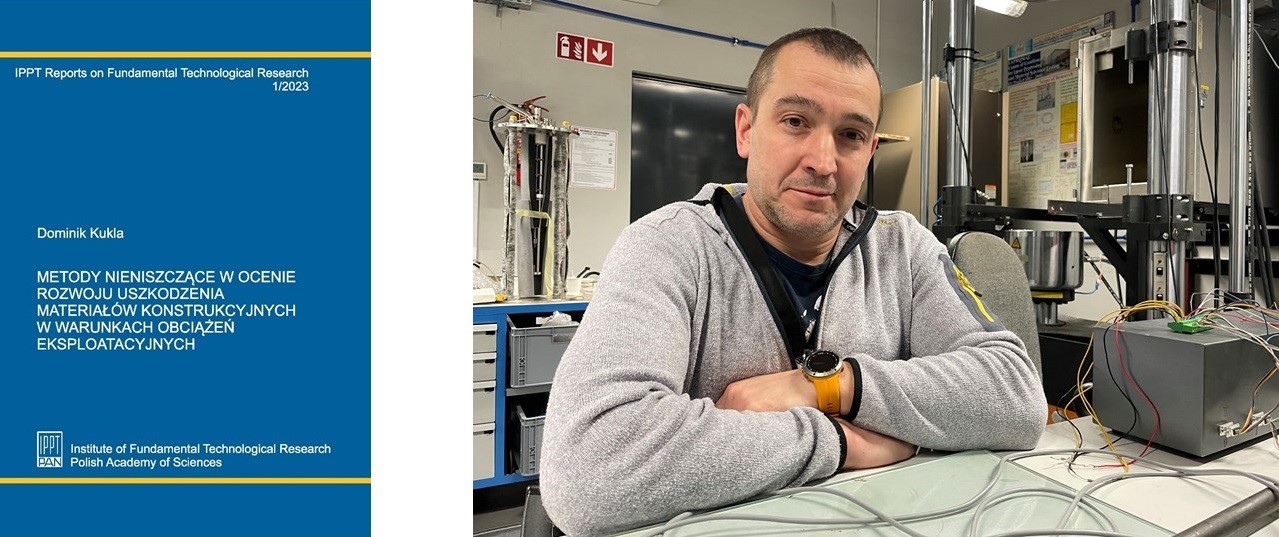The IPPT PAN has recently published a monograph by Dominik Kukla, PhD, entitled: "Non-destructive methods in the assessment of damage development in structural materials under service loads" (in Polish: “Metody nieniszczące w ocenie rozwoju uszkodzenia materiałów konstrukcyjnych w warunkach obciążeń eksploatacyjnych”).

The work, prepared in the Department of Experimental Mechanics of IPPT PAN, presents and summarizes the results of the author's many years of research. The main goal of the work was to demonstrate that it is possible to correlate parameters obtained by eddy current induction with macroscopic parameters of non-destructive techniques describing the development of fatigue damage at an early stage of its development.
The book concerns the application of eddy current and other non-destructive methods for the identification of local changes in the structure of material due to the development of damage under fatigue conditions. For selected, metallic structural engineering materials (steels, nickel, and aluminum alloys) subjected to cyclic alternating loads, the quantitative characteristics of damage development were presented and described based on the evolution of deformation components in subsequent load cycles. Along with the fatigue tests, a number of nondestructive diagnostic methods were used to assess the possibility of locating the fatigue failure initiation process in various materials. The proposed research procedures of the eddy current method, supported by optical techniques, allowed not only for early-stage identification of fatigue damage development areas but also to monitor the degradation process of specimens, up to their failure.
The eddy current measurements were carried out on alloys selected based on their (magnetic) properties and mechanisms of fatigue damage development. The tests of the heat-resistant steel specimens (1.4903) included fatigue tests with the determination of the deformation fatigue damage factor describing the dynamics of changes in the deformation components in subsequent load cycles. The results of these calculations were correlated with the measurements of the eddy current signal phase angle, carried out according to the developed procedure. This measurement was performed in selected areas on a specimen subjected to variable loads and after a predetermined number of fatigue cycles. Microstructural observations of specimens subjected to fatigue tests were also carried out in the field of metallography (transverse and longitudinal sections) as well as fractography (fractures). Microstructural studies confirmed the occurrence of processes and phenomena related to fatigue degradation, which may justify changes in the values of the eddy current signal parameters (phase angle) as a function of its development. Based on the eddy current analysis, a fatigue life determination methodology was developed.
Investigations were also performed on the MAR 247 nickel alloy used in the construction of turbine blades of aircraft engines. A series of specimens were subjected to fatigue tests and simultaneously monitored by non-destructive, optical testing techniques such as Digital Image Correlation (DIC) and Electronic Speckle Pattern Interferometry (ESPI). Subsequent conductivity measurements were performed on such specimens by using the eddy current method (according to the developed procedure), as well as classic defectoscopy tests. Optical techniques enabled an early identification of local strain concentrations resulting from local stress concentrations. In these areas, the development of the dominant crack propagation was observed. Such observations were further confirmed by the parallel eddy current tests, which also revealed other fatigue cracks at the stage preceding the development of the dominant damage. A local drop in the conductivity value in the area of damage initiation was also found in the form of strain concentration. Similar tests were also carried out for the Inconel 718 alloy by using specimens with a variable cross-sectional area enabling to obtain a variable deformation field. Additionally, an attempt to identify technological defects resulting from local overheating of the material structure by the grinding tool was made. The developed test procedures enabled the detection of defects related to grinding burns. The subsequent analysis of the parameters of the recorded impedance signal obtained by the eddy current method, allows the quantitative assessment of the depth of the overheating zone and the qualitative assessment of changes in the hardness of the layer, resulting from the effect of high temperature.
The problems presented in the monograph are part of a broader trend in the development of world science in the area of non-destructive and non-invasive methods of industrial diagnostics and assessment of damage to materials, including detection and assessment of fatigue-type damage at an early stage of its development. In addition to the strictly scientific and cognitive aspect of the publication, the practical application potential of the obtained results is also important.
The book was published in Polish in the book series “IPPT Reports on Fundamental Technological Research”.
More: Publishing Office















